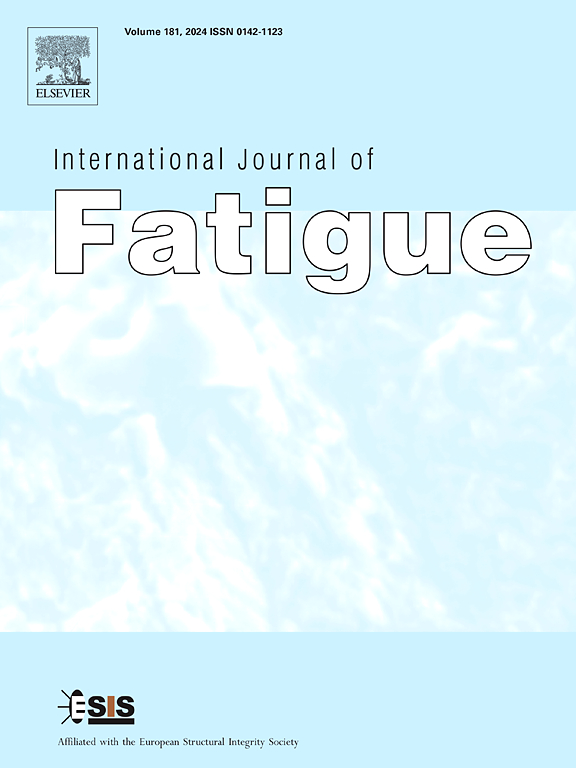ANN vs. theoretical models for predicting crack path in fretting fatigue
IF 5.7
2区 材料科学
Q1 ENGINEERING, MECHANICAL
引用次数: 0
Abstract
Fretting fatigue (FF) involves multiaxial and non-proportional stress states in addition to strong stress gradients, making crack propagation modeling challenging. In this work, we evaluate different models based on stress intensity factors (SIFs) to predict crack propagation kink angles under FF conditions, including both theoretical and artificial neural network (ANN) models. To train and test the ANN model, we collected FF data on Al alloys from six different sources in the literature, where the crack paths observed in the experiments were available. Testing data was also used to assess the performance of the theoretical models in predicting crack propagation kink angles. We demonstrate that the ANN model outperforms the theoretical models in predicting crack propagation kink angles. Finally, we compared the investigated models by simulating the crack propagation path under FF conditions using finite element modeling. The results indicate that, although the ANN model was more accurate in predicting the kink angle for a given crack configuration observed in the experiments, its performance was comparable to the theoretical models that account for non-proportional effects when estimating the crack propagation path. However, under high compressive states, the ANN model predicted more stable crack paths than the theoretical models.
预测微动疲劳裂纹路径的人工神经网络与理论模型
微动疲劳(FF)除了强应力梯度外,还涉及多轴和非比例应力状态,这使得裂纹扩展建模具有挑战性。在这项工作中,我们评估了基于应力强度因子(SIFs)的不同模型来预测FF条件下的裂纹扩展扭结角,包括理论模型和人工神经网络(ANN)模型。为了训练和测试人工神经网络模型,我们从六个不同的文献中收集了铝合金的FF数据,其中实验中观察到的裂纹路径是可用的。试验数据还用于评估理论模型在预测裂纹扩展扭结角方面的性能。我们证明了人工神经网络模型在预测裂纹扩展扭结角方面优于理论模型。最后,利用有限元模型模拟了FF条件下的裂纹扩展路径,并对所研究的模型进行了比较。结果表明,尽管在实验中观察到的给定裂纹形态下,人工神经网络模型在预测扭结角方面更为准确,但在估计裂纹扩展路径时,其性能与考虑非比例效应的理论模型相当。然而,在高压缩状态下,人工神经网络模型预测的裂纹路径比理论模型更稳定。
本文章由计算机程序翻译,如有差异,请以英文原文为准。
求助全文
约1分钟内获得全文
求助全文
来源期刊

International Journal of Fatigue
工程技术-材料科学:综合
CiteScore
10.70
自引率
21.70%
发文量
619
审稿时长
58 days
期刊介绍:
Typical subjects discussed in International Journal of Fatigue address:
Novel fatigue testing and characterization methods (new kinds of fatigue tests, critical evaluation of existing methods, in situ measurement of fatigue degradation, non-contact field measurements)
Multiaxial fatigue and complex loading effects of materials and structures, exploring state-of-the-art concepts in degradation under cyclic loading
Fatigue in the very high cycle regime, including failure mode transitions from surface to subsurface, effects of surface treatment, processing, and loading conditions
Modeling (including degradation processes and related driving forces, multiscale/multi-resolution methods, computational hierarchical and concurrent methods for coupled component and material responses, novel methods for notch root analysis, fracture mechanics, damage mechanics, crack growth kinetics, life prediction and durability, and prediction of stochastic fatigue behavior reflecting microstructure and service conditions)
Models for early stages of fatigue crack formation and growth that explicitly consider microstructure and relevant materials science aspects
Understanding the influence or manufacturing and processing route on fatigue degradation, and embedding this understanding in more predictive schemes for mitigation and design against fatigue
Prognosis and damage state awareness (including sensors, monitoring, methodology, interactive control, accelerated methods, data interpretation)
Applications of technologies associated with fatigue and their implications for structural integrity and reliability. This includes issues related to design, operation and maintenance, i.e., life cycle engineering
Smart materials and structures that can sense and mitigate fatigue degradation
Fatigue of devices and structures at small scales, including effects of process route and surfaces/interfaces.
 求助内容:
求助内容: 应助结果提醒方式:
应助结果提醒方式:


